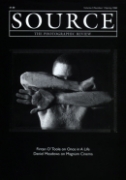Truths and Fictions
'Truths and Fictions' by Pedro Meyer was at the Gallery of Photography in Dublin, February 1996
Review by Frank Miller
Issue 7 Spring 1996
View Contents ▸
The Pedro Meyer show, Truths and Fictions, stopped in the Gallery of Photography, Dublin, in February during it's world tour. The work is remarkable if only because it heralds a new era in photography, warmly embracing the potential of digital manipulation of photographs. Manipulation of photographs has been with us since it's invention but Meyer brings things very much further by applying software packages such as Adobe Photoshop to the traditionally purist documentary medium. In effect Meyer combines elements from different images, often taken many years apart, to create what could be called fictional truths, if you can stomach the contradiction implied in the title. From the exhibition Truths and Fictions by Pedro Meyer
From the exhibition Truths and Fictions by Pedro Meyer
The work is a mixture of colour and monochrome and cleverly intersperses altered with unmanipulated photographs, playing on the irony that a few surreal looking images are in fact unaltered while some apparently 'straight' images have been manipulated. Thus we have a real looking photograph of a billboard man, wearing a television, in Central Park- and in fact it's three images combined. We have another of a tourist posing with cardboard with cardboard cutouts which looks fake, except it's 'real'. At this stage of course we're reaching for the inverted commas and the show has at least forced us to confront the application of words like real and true to photographs. A new word, perhaps digigraphs, is needed for these photographs which are in fact not photographs. There is a striking contrast between the colour and monochrome work in the show- the black and whites tend to be gritty and moody 'on the road' images a la Robert Frank, the colour work is highly saturated to the point of being lurid, the intention apparently being to create a magic realism effect. The prints themselves are interesting being large and made with a high end ink jet printer on art paper. They are signed, numbered and embossed leaving no doubts about their place in the art market.
The results are mixed. For this reviewer the majority of the images simply do not work - they fail to convince at any level beyond the technique applied in their creation and are instantly rejected by the eye as false in an auto-response akin to a bent coin in a coffee machine. In particular the colour prints are reminiscent of collages made from magazine cuttings. The perspectives are frequently 'wrong' making the images difficult to accept, probably quite intentionally. The metaphors are heavy-handed; in 'The Strolling Saint' a statue floats along a street; in 'The Temptation of the Angel' a young girl dressed as an angel sits by a chess table while a miniature old woman with burning twigs approaches. In 'Mexican with a Positive Attitude within a Negative Environment' the image fails miserably, a ridiculous visual pun combining negative and positive image which attempts to force a social point. In 'Religious Syncretism' a hand with an orange ball appears on the altar of a ruined church in Oaxaca, Mexico, the area in which most of the colour work was taken. So what??????!!!!! The black and white images fare somewhat better, perhaps the elements are more easily blended in a way which the eye is prepared to accept. The 'Walking Billboard' image, mentioned already, works well enough as does 'Emotional Crisis', an image of an open highway with a passing train, to which a massive advertising sign for a hospital with the words 'emotional crisis' has been added. The finishing touch is that the white dotted line in the middle of the road takes an emotional swerve. The monochrome work remains faithful in intention, and not in technique, to the documentary tradition of social commentary and is not without a wry humour.
In stark contrast to the digigraphs a small selection of Meyer's photographs from another show 'I Photograph to Remember' were on view. The pictures of his father as he heard the news that he had only weeks to live and of his mother having her head shorn for an operation are standout images of uncompromising honesty and instantly demand an emotional response from the viewer. The strength of these photographs undermine the technique-driven images in 'Truths and Fictions', an exhibition which may change the way we look at photographs, but ultimately contains rather less than meets the eye.
The show is accompanied by an interactive CD-ROM, useful for looking at the techniques, and an Aperture book, containing quotes "relating to the new medium". My favourite is from the respected London Independent Magazine picture editor Colin Jacobson: "...I am beginning to salt away black-and-white prints, in plain brown cardboard boxes, waiting for the call to flee".
Other articles by Frank Miller:
Other articles mentioning Robert Frank:
Other articles on photography from the 'Manipulated' category ▸






